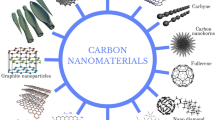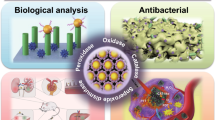Abstract
Metal-organic frameworks (MOFs) composed of functional metal ions/clusters and suitable bridging ligands are highly designable, which have shown excellent catalytic activity as nanozymes and are promising for antibacterial therapy. Herein, two-dimensional (2D) copper MOF nanosheets (Cu-MOF NSs) as effective antibacterial agents were prepared through a simple one-step method. The 2D Cu-MOF NSs displayed a peroxidase-like activity toward H2O2 decomposition into highly cytotoxic hydroxyl radicals (•OH). Notably, the 2D morphology of Cu-MOF NSs provides a high density of Cu2+/Cu+ surface active sites, which could efficiently oxidize the proteins and lipids on the bacterial surface and induce the death of bacteria. It is found that the as-prepared 2D Cu-MOF NSs exhibited antibacterial properties against Staphylococcus aureus (S. aureus) and could efficiently eradicate the biofilm of S. aureus. Up to 99.9% bacteria were killed at a Cu-MOF concentration of 4 µg/mL. This study opens a new avenue for the design of MOF-based antibacterial agents to combat pathogenic bacterial infections.
Similar content being viewed by others
References
Jones K E, Patel N G, Levy M A, et al. Global trends in emerging infectious diseases. Nature, 2008, 451: 990–993
Fisher R A, Gollan B, Helaine S. Persistent bacterial infections and persister cells. Nat Rev Microbiol, 2017, 15: 453–464
Brown E D, Wright G D. Antibacterial drug discovery in the resistance era. Nature, 2016, 529: 336–343
Blaser M J. Antibiotic use and its consequences for the normal microbiome. Science, 2016, 352: 544–545
Taubes G. The bacteria fight back. Science, 2008, 321: 356–361
Zhao Y Q, Sun Y, Zhang Y, et al. Well-defined gold nanorod/polymer hybrid coating with inherent antifouling and photothermal bactericidal properties for treating an infected hernia. ACS Nano, 2020, 14: 2265–2275
Wu S M, Li A H, Zhao X Y, et al. Silica-coated gold-silver nanocages as photothermal antibacterial agents for combined anti-infective therapy. ACS Appl Mater Interfaces, 2019, 11: 17177–17183
Wang W S, Cheng X H, Liao J W, et al. Synergistic photothermal and photodynamic therapy for effective implant-related bacterial infection elimination and biofilm disruption using Cu9S8 nanoparticles. ACS Biomater Sci Eng, 2019, 5: 6243–6253
Han Q, Lau J W, Do T C, et al. Near-infrared light brightens bacterial disinfection: Recent progress and perspectives. ACS Appl Bio Mater, 2021, 4: 3937–3961
He W, Kim H K, Wamer W G, et al. Photogenerated charge carriers and reactive oxygen species in ZnO/Au hybrid nanostructures with enhanced photocatalytic and antibacterial activity. J Am Chem Soc, 2014, 136: 750–757
Li W, Wang Y, Qi Y, et al. Cupriferous silver peroxysulfite super-pyramids as a universal and long-lasting agent to eradicate multidrug-resistant bacteria and promote wound healing. ACS Appl Bio Mater, 2021, 4: 3729–3738
Dharmaraja A T. Role of reactive oxygen species (ROS) in therapeutics and drug resistance in cancer and bacteria. J Med Chem, 2017, 60: 3221–3240
Deng Q, Sun P, Zhang L, et al. Porphyrin MOF dots-based, function-adaptive nanoplatform for enhanced penetration and photodynamic eradication of bacterial biofilms. Adv Funct Mater, 2019, 29: 1903018
Teng W, Zhang Z, Wang Y, et al. Iodine immobilized metal-organic framework for NIR-triggered antibacterial therapy on orthopedic implants. Small, 2021, 17: 2102315
Pan X, Bai L, Wang H, et al. Metal-organic-framework-derived carbon nanostructure augmented sonodynamic cancer therapy. Adv Mater, 2018, 30: 1800180
Song M, Cheng Y, Tian Y, et al. Sonoactivated chemodynamic therapy: A robust ROS generation nanotheranostic eradicates multidrug-resistant bacterial infection. Adv Funct Mater, 2020, 30: 2003587
Wang H, Wan K, Shi X. Recent advances in nanozyme research. Adv Mater, 2019, 31: 1805368
Xi J, Wei G, An L, et al. Copper/carbon hybrid nanozyme: Tuning catalytic activity by the copper state for antibacterial therapy. Nano Lett, 2019, 19: 7645–7654
Chu C C, Su M, Zhu J, et al. Metal-organic framework nanoparticle-based biomineralization: A new strategy toward cancer treatment. Theranostics, 2019, 9: 3134–3149
Wang S, McGuirk C M, d’Aquino A, et al. Metal-organic framework nanoparticles. Adv Mater, 2018, 30: 1800202
Shen M, Forghani F, Kong X, et al. Antibacterial applications of metal-organic frameworks and their composites. Comprehensive Rev Food Sci Food Saf, 2020, 19: 1397–1419
Li R, Chen T, Pan X X. Metal-organic-framework-based materials for antimicrobial applications. ACS Nano, 2021, 15: 3808–3848
Yang Y, Wu X Z, He C, et al. Metal-organic framework/Ag-based hybrid nanoagents for rapid and synergistic bacterial eradication. ACS Appl Mater Interfaces, 2020, 12: 13698–13708
Li J, Song S, Meng J, et al. 2D MOF periodontitis photodynamic ion therapy. J Am Chem Soc, 2021, 143: 15427–15439
Zhang L, Liu Z, Deng Q, et al. Nature-inspired construction of MOF@COF nanozyme with active sites in tailored microenvironment and pseudopodia-like surface for enhanced bacterial inhibition. Angew Chem Int Ed, 2021, 60: 3469–3474
Hu W C, Younis M R, Zhou Y, et al. In situ fabrication of ultrasmall gold nanoparticles/2D MOFs hybrid as nanozyme for antibacterial therapy. Small, 2020, 16: 2000553
Xiao F F, Cao B, Wen L W, et al. Photosensitizer conjugate-functionalized poly(hexamethylene guanidine) for potentiated broad-spectrum bacterial inhibition and enhanced biocompatibility. Chin Chem Lett, 2020, 31: 2516–2519
Wu S M, Xu C, Zhu Y W, et al. Biofilm-sensitive photodynamic nanoparticles for enhanced penetration and antibacterial efficiency. Adv Funct Mater, 2021, 31: 2103591
Hu D F, Deng Y Y, Jia F, et al. Surface charge switchable supra-molecular nanocarriers for nitric oxide synergistic photodynamic eradication of biofilms. ACS Nano, 2020, 14: 347–359
Hou L, Liu Y, Liu W, et al. In situ triggering antitumor efficacy of alcohol-abuse drug disulfiram through Cu-based metal-organic framework nanoparticles. Acta Pharmaceutica Sin B, 2021, 11: 2016–2030
Gao L, Wu Z, Ibrahim A R, et al. Fabrication of folic acid-decorated hollow ZIF-8/Au/CuS Nanocomposites for enhanced and selective anticancer therapy. ACS Biomater Sci Eng, 2020, 6: 6095–6107
Cai J, Li Y, Zhang M, et al. Cooperation in Cu-MOF-74-derived Cu-Cu2O-C nanocomposites to enable efficient visible-light-initiated phenylacetylene coupling. Inorg Chem, 2019, 58: 7997–8002
Li M, Qiang Z, Pulgarin C, et al. Accelerated methylene blue (MB) degradation by Fenton reagent exposed to UV or VUV/UV light in an innovative micro photo-reactor. Appl Catal B, 2016, 187: 83–89
Fan W L, Qi Y, Wang R, et al. Calcium carbonate-methylene blue nanohybrids for photodynamic therapy and ultrasound imaging. Sci China Life Sci, 2018, 61: 483–491
Flemming H C, Wingender J, Szewzyk U, et al. Biofilms: An emergent form of bacterial life. Nat Rev Microbiol, 2016, 14: 563–575
Flemming H C, Wingender J. The biofilm matrix. Nat Rev Microbiol, 2010, 8: 623–633
Author information
Authors and Affiliations
Corresponding authors
Additional information
This work was supported by the National Natural Science Foundation of China (Grant Nos. 52173271, 51922022 and 51773013), the Beijing Outstanding Young Scientist Program (Grant No. BJJWZYJH0120191001-0024), the China Postdoctoral Science Foundation (Grant Nos. 2021T140044 and 2020M670110), the Beijing Municipal Natural Science Foundation (Grant No. 2214074), the Beijing Municipal Science and Technology Project (Grant No. Z191100006619099), and the Fundamental Research Funds for the Central Universities (Grant Nos. BHYC1705A and XK1802-2).
Rights and permissions
About this article
Cite this article
Wang, Z., Guo, W., Zhang, K. et al. Two-dimensional copper metal-organic frameworks as antibacterial agents for biofilm treatment. Sci. China Technol. Sci. 65, 1052–1058 (2022). https://doi.org/10.1007/s11431-021-1963-3
Received:
Accepted:
Published:
Issue Date:
DOI: https://doi.org/10.1007/s11431-021-1963-3




